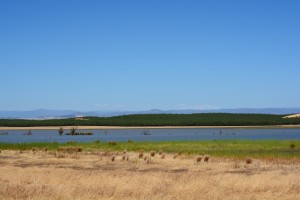
Between 1999 and 2003, the public works department repeatedly told the Modesto City Council that the city needn’t worry about water supplies for many years. In fact, water managers worried that if we didn’t use more surface water, we could lose water rights by state edict. Yet, Modesto citizens have been on water rationing since the late 1980’s, with restrictions on landscape watering.
Earlier this year, the State of California ordered Modesto to cut water use by 36 percent, even though citizens have been conserving for many years. How can we reconcile the requirement of further cutbacks with the fact that no shortage of city owned water exists?
Modesto’s water comes from surface and groundwater sources. Surface water comes from rain and snow runoff from the Sierra Nevada. The water arrives via diversions from the Tuolumne River to Modesto Reservoir. There, a purification plant makes the water suitable for human consumption and then pipes it to Modesto.
Modesto also pumps groundwater. Water accumulates in wet years and is drafted by the city in dry years.
Unfortunately, the groundwater supply is in jeopardy from plumes of toxic chemicals that were dumped into the ground years ago by a major dry cleaning company and by the old FMC factory located near freeway 99. Other sources, such as leaking tanks from gasoline stations, have also contaminated ground water. When a plume reaches a city well, the city stops using it. Clean up efforts have been negligible; Modesto has not had a water shortage as an incentive to make the effort.
The present combination of water sources makes the city’s water supply secure; this situation could change if someone decides to sell water outside the area or the state takes it by legal force.
Origins of Water Rationing
As Modesto’s population grew from 107,000 people in 1980 to over 200,000 people today, water demand increased. As water consumption increased, problems developed in maintaining adequate water pressure. During peak demand periods in the summer, water pressure dropped so low that many citizens complained.
At the time, the city council had two choices for addressing low water pressure: ration water so that water pressure would stay up or improve infrastructure so that more water could be delivered simultaneously city wide. The council chose rationing. Citizen complaints were minimized by telling everyone that conservation was good and necessary. While folks in the rest of California used as much water as they wanted, Modestans set an example by conserving.
The upside of the decision not to expand infrastructure was to save of millions of dollars in improvement costs; the council avoided raising water rates. Keeping rates low is a prime directive of the citizens of Modesto.
The Downside of Water Rationing
The downside of the water rationing is that now citizens are mandated to cut use by another 36 percent; the mandate is much more painful for citizens of Modesto than elsewhere because we were already conserving water.
When Modesto had a flat rate for unlimited water use, conservation cut costs. Because water rates were based on lot size, the city’s water sales became profitable after rationing began. The city council used the profit from water sales for other purposes. Money went into the general fund and the Del Este Water system was purchased to expand city’s service area.
When Proposition 218 made profit from a city’s water sales illegal, diverting funds for non-water uses had to stop or face citizen lawsuits.
When Modesto was forced by state law to install meters and charge by volume, the water fund became dependent on consumption. Higher consumption would provide more money for operations. The present 36 percent mandated cut in water use has resulted in a major loss of income to the city from water sales. Now, the city council needs to raise water rates to make up for lost income.
Insufficient Water Funds
In the past decade, water rates have not increased substantially in Modesto. As a result, the shortage of funds within the public works department has resulted in a backlog of deferred maintenance. City crews work feverishly each day to plug leaks and deal with emergencies such as broken mains and pipes.
In my neighborhood, I reported a broken water main at Dulwich and Brandeis streets just a few days ago. The streets were flooded above the sidewalk as a small geyser erupted in the street.
The maintenance deficit is compounded by the large number of city trees, whose roots break water lines. In the last four months, three city water lines have broken within sight of my home.
As time goes by, the stress on water system infrastructure keeps growing. Service has been reliable, but one has to wonder how long the system can sustain the continuous deterioration. If the city council decides to raise rates, the increase will most likely occur shortly after an election, for obvious reasons.
